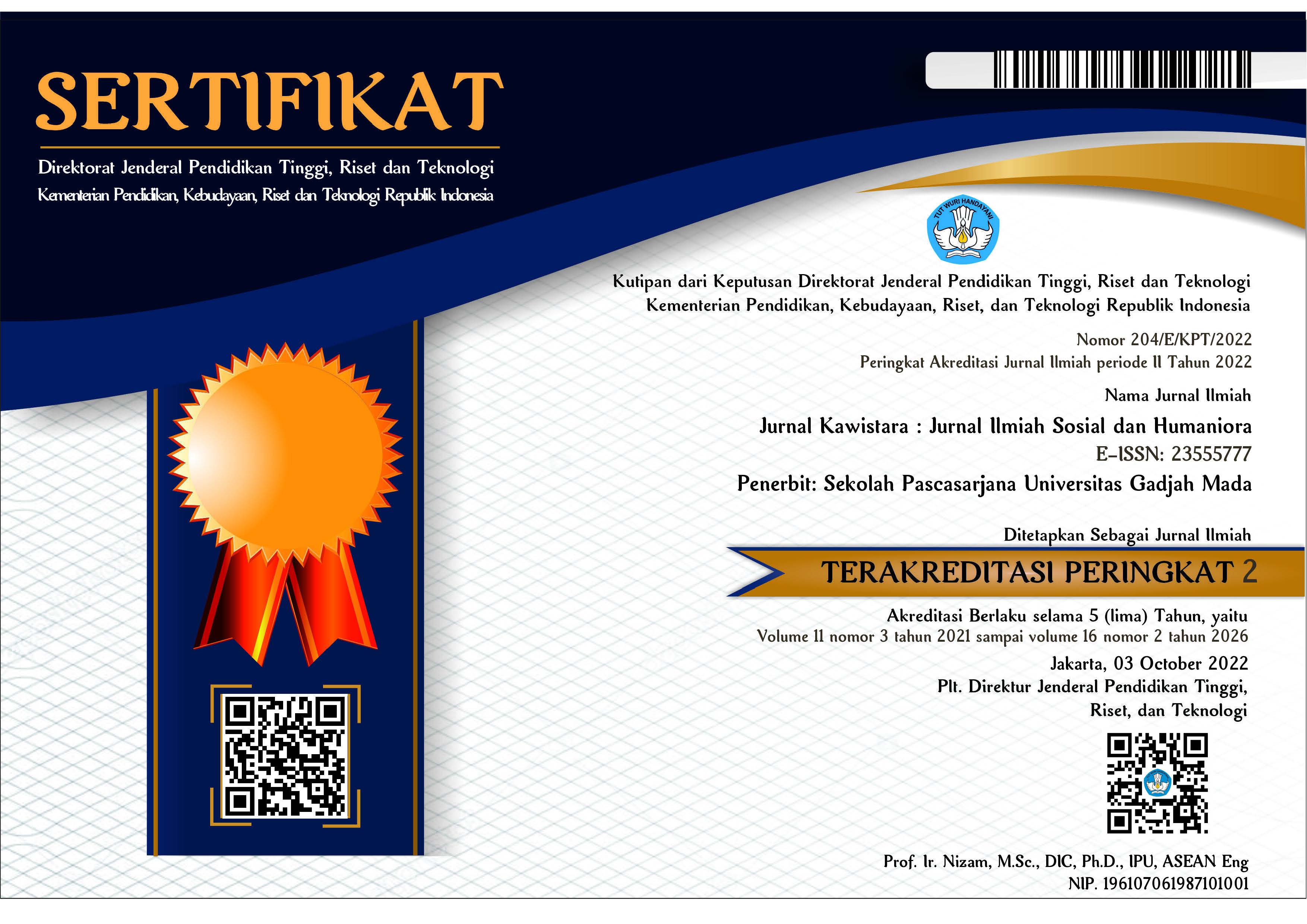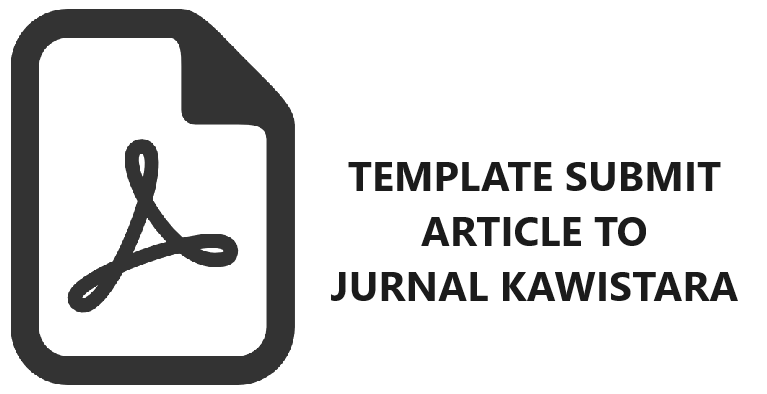JILBAB DAN REPRODUKSI IDENTITAS PEREMPUAN KRISTEN RUANG PUBLIK SEKOLAH ACEH
Muhammad Ansor(1*), Cut Intan Meutia(2)
(1) Institut Agama Islam Negeri Langsa-Aceh
(2) Institut Agama Islam Negeri Langsa-Aceh
(*) Corresponding Author
Abstract
The article examined the experiences of Christian women teachers in the public space of school in Aceh.
Based on the narrated biographies of seven teachers, this article focuses on exploring the regulation
impact of Islamic dress code toward formation of Christian women’s identity in Aceh. The source of
data is collected through observation and semi-structured interviews during 2013- 2014. The article
uses the habitus theory from Bourdieu and the identity concept of ‘in between’ from Bhaba. This article
shows that the public space of school becomes the arena of power contestation between Moslem and
the minority, the Christian women, which led to the inclination of Christian women to wear headscraft.
The article also shows that the implementation of Islamic sharia encourages the emergence of hybrid
identity of the veiled Christian women. This hybrid identity was born from the result of complicated
negotiation between identities as women teacher, Christian, and citizen of Aceh.
Keywords
References
] Abu-Lughod, L. 2002. Do Muslim Women Really Need Saving? Antropological Reflection on Cultural Relativism and Its Others. American Anthropologist 104(3): 783-790.
] Adams, M. 2006. Hybridizing Habitus and Reflexivity: Towards an Understanding of Contemporary Identity?.Sociology 40(3): 511-528.
] Ansor, Muhammad. 2014a. ‘’Kita Kan Beda!”:Persamaan Remaja Perempuan Muslim dan Kristen di Langsa,Aceh’. Harmoni 13(2): 37-50.
] Ansor, Muhammad. 2014b. “Being Women in the Land of Sharia: Politics of Female Body, Piety and Resistance in Langsa, Aceh.” Al-Jamiah 52(1):60-83.
] Ansor, Muhammad. 2016. “Under the Shadow of Sharia: Christian Muslim Relations from Acehnese Christian Experience.” Komunitas 8(1): 125-134.
] Barter, S.J. 2011. ‘Ulama, the State, and War:Community Islamic Leaders in the Aceh Conflict’.Contemporary Islam 5(1): 19-36.
] Berman, L. 1998. Speaking through the Silence:Narratives, Social Conventions, and Power in Java. New York and Oxford:Oxford University Press.
] Bhabha, H.K. 1990. Introduction: Narrating of the Nation. Nation and Narration.Editor Homi K. Bhabha.London and New York: Routlegde.
] Bhabha, H.K. 1994. The Location of Culture,London and New York: Routlegde.Bhabha, H.K. 1996. Culture’s In-Between. Questions of Cultural Identity. Editor S. Hall dan P.D. Gay. London,Thousand Oaks and New Delhi:Sage Publications.
] Bourdieu, P. 1977. Outline of a Theory of Practice. Cambrigde: Cambrigde University Press.
] Bourdieu, P. and L. Wacquant. 1992. An Invitation to Reflexive Sociology. Cambrigde: Policy Press.Bourdieu, P. 1993. The Field of Cultural Production:Essay on Art and Literature. United States: Columbia University Press.
] Bourdieu, P. 1979. Distinction: A Social Crituque of the Judgement of Taste.Cambrigde, MA: Havard University Press.
] Bowen, J.R. 2007. Why the French Don’t Like Headscarves: Islam, the State and Public Space. Princeton and Oxford:Princeton University Press.
] Budiman, H. 2005. Minoritas, Multiculturalisme,Modernitas. Hak Minoritas:Dilema Multiculturalisme di Indonesia.Jakarta: Yayasan Interseksi dan Tifa Foundation.
] Bun, K.H. 2006. Body, Dress and Cultural Exclusion: Experiences of Pakistani Women in ‘Global’ Hongkong. Asian Ethnicity. 7(3): 285-302.
] Cinar, A. 2005. Modernity, Islam and Secularism in Turkey: Bodies Places and Time. London, University of Minnesota Press.
] Davary, B. 2009. Miss Elsa and the Veil: Honor,Shame, and Identity Negotiation’.Journal of Feminist Studies in Religion.25(2): 47-66.
] Droeber, J. 2012. ’We Are Different!’Similarities between Christian and Muslim Women in Jordan, Islam and Christian-Muslim Relation 23(1): 59-78.
] Eickelman, D.F. and J.F. Anderson. 2003.Redefining Muslim Publics. New Media in the Muslim World: The Emerging Public Sphere. Editor D.F.Eickelman and J.F. Anderson.Blomington and Indiana Polis:Iandiana University Press.
] Friedman, B. dan P. Merle. 2013. Veiled Threats: Decentering and Unification in Transnational News Coverage of the French Veil Ban. Feminis Media Studies 13(5): 770-780.
] Gomes-Estren, B.M. dan M.L. de la Mata Benitez. 2013. Narratives of Migration: Emotion and the Interweaving of Personal and Cultural Identity through Narrative.Culture & Psychology 9(3): 348-368.
] Habermas, Jurgen. 1989. The Structural Transformation of the Public Sphere:An Inquiry into Category of Bourgeois Society. Cambrigde: MIT Press.
] Haddad, M. 2000. Christian Identity in the Jordanian Arab Culture: A Case Study of Two Communities in North Jordan. Jornal of Muslim Minority Affairs. 20(1): 137-146.
] Hall, S. 1996. Introduction: Who. Needs ‘Identity’?. Questions of Cultural Identity, Editor S. Hall and P.D. Gay.London, Thousand and New Delhi:Sage Publications.
] Honarbin-Hollyday, M. 2010. Becoming Visible in Iran: Women in Contemporary Iran Society. London and New York:Tauris Academic Studies.
] Howard, E. 2012. Banning Islamic Veil: Is Gender Equality a Valid Argument?International Journal of Discrimination and the Law. 12(3): 147-165.
] Islam, M.K. 2010. Headscarf Politics in Turkey:A Postcolonial Reading, New York:Palgrave Macmillan.
] Jenkins, R. 2004. Social Identity. Second Edition. London: Routlegde.
] Keaton, T.D. 2006. Muslim Girls and the Othe France: Race, Identity Politics and Social Exclusion. Bloomington and Indianapolis: India University Press.
] Kyimlicka, W. 1995. Multicultural Citizenship:A Liberal Theory of Minority Right.New York: Oxford University Press.
] Liu, J. 2012. Habitus of Translators as Socialized Individuals: Bourdieu’s Account. Theory and Practice in Language Studies, 2(6): 1168-1173.
] Mahmood, S. 2005. Politics of Piety: The Islamic Revival and The Feminist Subject.Princeton and Oxford: Princeton University Press.
] Maxwell, R. dan E. Bleich. 2014. What makes Muslims Feel French? Social Forces 93(1): 155-179.
] Merry. M.S. dan J.A. Milligan. 2009.Complexities of Belonging in Democratic and Democratizing Societies: Islamic Identity, Ethnicity and Citizenship in the Netherland and Aceh. Journal of Muslim Minority Affairs. 29(3): 311-323.
] Milallos, M.T.R. 2007. Muslim Veil as Politics:Political Autonomy, Women and Shari’a Islam in Aceh. Contemporary Islam 1(3): 289-301.
] Mujiburrahman. 2006. Feeling Threatened:Muslim-Christian Relations in Indonesia’s New Order. Leiden:Amsterdam University Press.
] Parekh, B. 2008. Rethinking Multiculturalism:Keberagaman Budaya dan Teori Politik,Yogyakarta: Kanisius and Impulse.
] Rabo, A. 2012. ‘We are Christian and We Are Equal Citizens’: Perspectives on Particularity and Pluralism in Contemporary Syria. Islam and Muslim-Christian Relations 12(1): 79-93.
] Raijman, R. dan Y. Pinsky, 2013. Religion,Ethnicity and Identity: Former Soviet Christian Immigrants in Israel, Etnic and Racial Studies 36(11):1687-1705.
] Rinaldo, R. 2014. Pious and Critical: Muslim Women Activities and the Question of Agency. Gender and Society.20(10):1-23.
] Safitri, D.M. 2010. What Went Wrong with the Veil? A Comparative Analysis of the Discourse of the Veil in France,Iran, and Indonesia. Al-Jamiah.48(1):81-100.
] Safrilsyah. 2012. Non-Muslim Under the Regulation of Islamic Law in Aceh Province, Conference Proceding Annual International Conference on Islamic Studies (AICIS) XII Surabaya.5-8 November: 417-426.
] Sagi, F.N. 2011. Religion and the State in Turkis Universities. Macmillan: Palgrave.
] Salim, A. 2009.Challenging the Secular State:The Islamization of Law in Modern Indonesia. Honohulu:University of Hawai Press.
] Samuel, C. 2013. Syimbolic Violence and Collective Identity: Pierre Bourdieu and the Ethics of Resistance. Social Movement Studies: Journal of Social,Culture and Political Protes. 12(4): 397-413.
] Siegal, J.T. 1969. The Rope of God. Berkeley and Los Angeles: University of California Press.
] Smuts, L. 2011. Coming Out As a Lesbian in Johannesburg, South Africa:Considering Intersecting Identities and Social Spaces. South African Review of Sociology. 42(3): 23-40.
] Spivak, G.C. 1988. Can Subaltern Speak? Marxism and the Interpretation of Culture. Editor C. Nelson and L.Grossberg. Urbana: University of Illionis Press.
] Srimulyani, E. 2013. Islamic Schooling in Aceh: Change, Reform, and Local Context. Studia Islamika: Indonesian Journal for Islamic Studies. 20(3): 464-487.
] Tunc, A. and A. Ferentinou. 2012. Identities In-Between: the Impact of Satellite Broadcasting on Greek Orthodox Minority (Rum Polites) Women’s Perception of Their Identities in Turkey. Ethnic and Racial Studies 35(5): 906-923.
] Werbner, P. 2007. Veiled Intervention in Pure Space: Honour, Shame and Embodied Struggles among Muslims in Britain and France. Theory, Culture and Society 24(2): 161-186.
] Winchester, D. 2008. Embodying the Faith:Religious Practices and the Making of a Moral Habitus. Social Forces 86(4): 1753-1780.
Article Metrics
Refbacks
- There are currently no refbacks.
Copyright (c) 2016 Muhammad Ansor, Cut Intan Meutia

This work is licensed under a Creative Commons Attribution-ShareAlike 4.0 International License.
Jurnal Kawistara is published by the Graduate School, Universitas Gadjah Mada.











